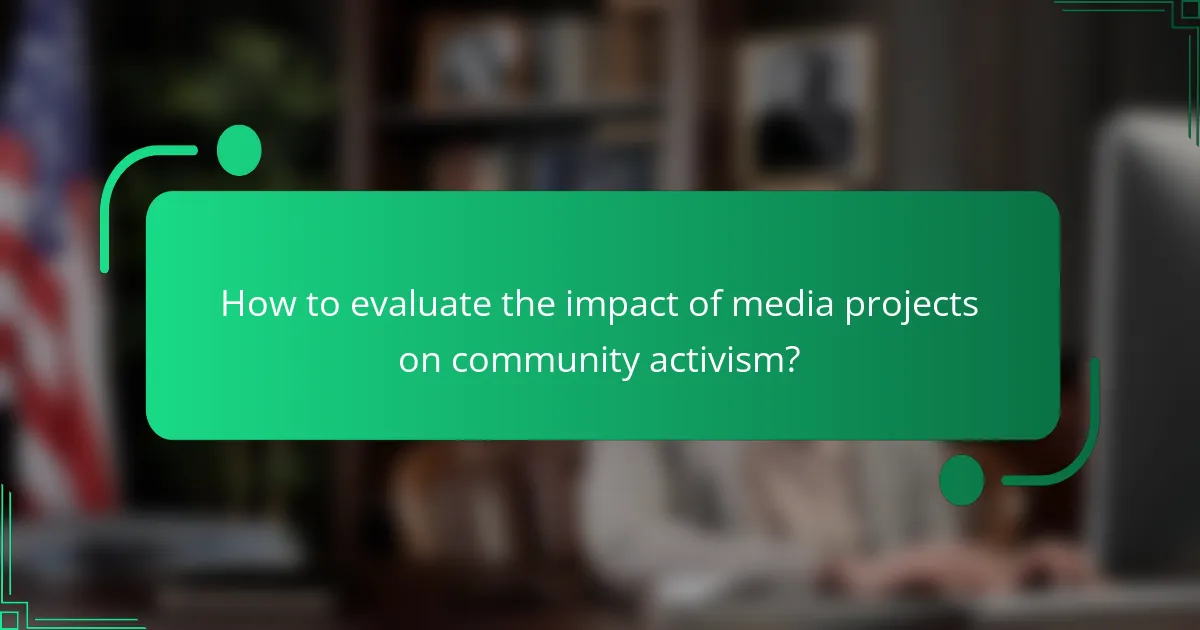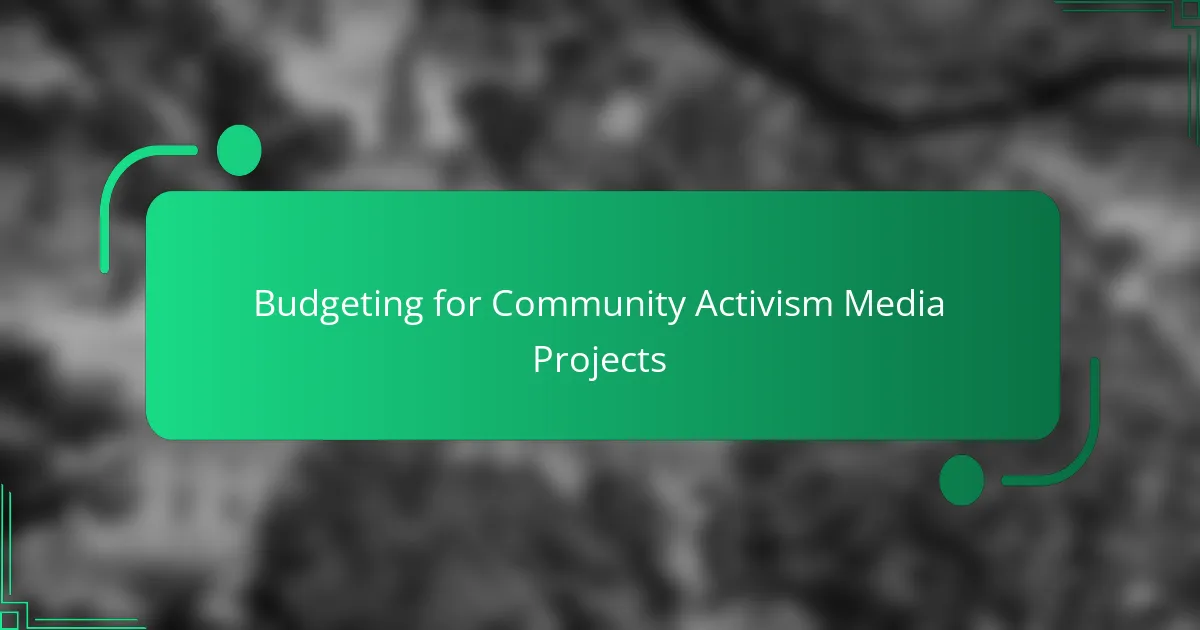Budgeting for community activism media projects is crucial for ensuring their success and sustainability. By clearly defining your goals and estimating total costs, you can allocate resources effectively. Exploring various funding sources, such as grants and crowdfunding, will help you align financial support with your project’s objectives and community needs.

How to budget for community activism media projects effectively?
To budget effectively for community activism media projects, start by clearly defining your goals and estimating the total costs. This approach ensures that resources are allocated wisely and that the project remains financially sustainable.
Identify project goals and objectives
Begin by outlining the specific goals and objectives of your media project. Consider what you aim to achieve, such as raising awareness, mobilizing community members, or influencing policy changes. Clear objectives will guide your budgeting process and help prioritize spending.
For example, if your goal is to produce a documentary, objectives might include securing interviews, filming locations, and post-production editing. Each objective will require different resources, which should be reflected in your budget.
Estimate total project costs
Estimating total project costs involves identifying all potential expenses associated with the project. This includes direct costs like equipment rental, personnel, and materials, as well as indirect costs such as marketing and distribution. A comprehensive list will help avoid unexpected financial shortfalls.
Consider using a simple spreadsheet to categorize costs into fixed and variable expenses. Fixed costs might include venue rentals, while variable costs could include travel expenses that fluctuate based on project needs. Aim for a budget range that allows for flexibility, typically adding a contingency of around 10-15% for unforeseen expenses.
Allocate funds to specific activities
Once you have a total cost estimate, allocate funds to specific activities based on their priority and importance. This step ensures that critical components of the project receive adequate funding while less essential activities are scaled back if necessary.
For instance, if filming is a priority, allocate a larger portion of your budget to equipment and crew. Conversely, if outreach is less critical, you might reduce spending on promotional materials. Regularly review these allocations to ensure they align with your evolving project needs.
Monitor and adjust budget regularly
Monitoring and adjusting your budget throughout the project lifecycle is crucial for financial health. Regularly track actual spending against your budget to identify any discrepancies early. This practice allows for timely adjustments to avoid overspending.
Set up monthly budget reviews to assess progress and make necessary changes. If certain activities are underfunded or overfunded, reallocate resources as needed. This proactive approach helps maintain financial control and ensures that the project stays on track to meet its goals.

What are common funding sources for community activism media projects?
Common funding sources for community activism media projects include grants, crowdfunding, local business sponsorships, and government funding programs. Each source has its own advantages and considerations, making it essential to evaluate which options align best with your project’s goals and community needs.
Grants from nonprofit organizations
Grants from nonprofit organizations are a popular funding source for community activism media projects. These grants often focus on specific issues such as social justice, environmental advocacy, or community development. To secure a grant, you typically need to submit a detailed proposal outlining your project’s objectives, budget, and expected impact.
Many nonprofits have specific eligibility criteria and application deadlines, so it’s crucial to research potential funders thoroughly. Look for organizations that align with your mission and values to increase your chances of success.
Crowdfunding platforms like Kickstarter
Crowdfunding platforms like Kickstarter allow you to raise small amounts of money from a large number of people, making them an effective option for community activism media projects. You create a campaign page that outlines your project, sets a funding goal, and offers rewards for backers at various contribution levels.
Successful crowdfunding campaigns often rely on strong marketing and community engagement. Promote your campaign through social media and local networks to reach potential backers. Keep in mind that these platforms typically charge fees, so factor that into your budget.
Local business sponsorships
Local business sponsorships can provide financial support for community activism media projects while fostering partnerships within the community. Businesses may be willing to sponsor projects that align with their values or enhance their visibility in the area.
When approaching local businesses for sponsorship, prepare a clear proposal that outlines the benefits for them, such as advertising opportunities or community goodwill. Building relationships with local business owners can lead to ongoing support for future projects.
Government funding programs
Government funding programs at the local, state, or federal level can offer substantial financial resources for community activism media projects. These programs often aim to support initiatives that promote civic engagement, education, or public health.
To access government funding, familiarize yourself with available grants and their application processes. Be prepared to demonstrate how your project aligns with government priorities and contributes to community well-being. Keep track of deadlines and required documentation to ensure a smooth application process.

How to create a fundraising strategy for media projects?
Creating a fundraising strategy for media projects involves clearly defining your goals, identifying potential funding sources, and effectively communicating your project’s value. A well-structured approach can significantly enhance your chances of securing financial support.
Develop a compelling project narrative
A strong project narrative is essential for attracting donors and supporters. It should clearly articulate the project’s purpose, its impact on the community, and why it matters. Use storytelling techniques to engage your audience emotionally and make the project relatable.
Include specific details, such as the target audience and the expected outcomes. Highlight any unique aspects of your project that differentiate it from others, which can make it more appealing to potential funders.
Engage with the community for support
Community engagement is crucial for building a solid support base. Organize events, workshops, or focus groups to gather input and foster relationships. This not only helps in refining your project but also creates advocates who are more likely to contribute financially.
Consider forming partnerships with local organizations or influencers who share similar goals. Their endorsement can lend credibility to your project and expand your reach within the community.
Utilize social media for outreach
Social media platforms are powerful tools for outreach and fundraising. Create dedicated pages or profiles for your project to share updates, success stories, and calls to action. Use visuals and engaging content to capture attention and encourage sharing.
Leverage platforms like Facebook, Instagram, and Twitter to reach diverse audiences. Consider running targeted ad campaigns to promote fundraising events or initiatives, ensuring you allocate a budget that aligns with your overall fundraising strategy.

What are the key expenses in community activism media projects?
Key expenses in community activism media projects typically include production costs, marketing and distribution expenses, and investments in equipment and technology. Understanding these expenses helps organizations budget effectively and allocate resources to maximize impact.
Production costs for media content
Production costs encompass all expenses related to creating media content, such as video, audio, or written materials. This can include hiring professionals like videographers, editors, and writers, as well as costs for location permits and set design. Depending on the project’s scope, production costs can range from a few hundred to several thousand dollars.
To manage production expenses, consider using volunteers or local talent, which can significantly reduce costs. Additionally, planning shoots efficiently and minimizing location changes can help keep budgets in check.
Marketing and distribution expenses
Marketing and distribution expenses involve promoting the media content to reach the target audience effectively. This includes costs for social media advertising, print materials, and event promotions. Depending on the chosen platforms and strategies, these expenses can vary widely, often ranging from a few hundred to several thousand dollars.
To optimize marketing budgets, focus on low-cost strategies like grassroots outreach and leveraging community partnerships. Utilizing social media platforms effectively can also enhance reach without significant financial investment.
Equipment and technology investments
Investments in equipment and technology are crucial for producing high-quality media content. This can include cameras, microphones, editing software, and hosting platforms. While initial costs can be substantial, many organizations find that investing in good equipment pays off in the long run by improving production quality.
Consider renting equipment or using community resources to lower upfront costs. Additionally, explore open-source software options for editing and distribution, which can help keep technology expenses manageable.

What tools can help manage budgets for media projects?
Several tools can effectively manage budgets for media projects, helping activists track expenses and allocate resources efficiently. These tools range from traditional spreadsheet software to specialized budgeting apps and project management platforms.
Spreadsheet software like Microsoft Excel
Spreadsheet software, such as Microsoft Excel, is a versatile tool for budgeting. It allows users to create customized budget templates, track expenses, and perform calculations easily. You can set up categories for different project costs, such as equipment, marketing, and personnel, which helps in visualizing where funds are allocated.
To maximize its effectiveness, consider using formulas to automate calculations and pivot tables for summarizing data. Regularly updating your spreadsheet will ensure that you have an accurate view of your budget status, which is crucial for making informed financial decisions.
Budgeting apps such as YNAB
Budgeting apps like You Need A Budget (YNAB) offer a user-friendly interface specifically designed for tracking finances. These apps typically feature real-time expense tracking, budget creation, and goal-setting functionalities. YNAB, for example, encourages users to assign every dollar a job, which can help prioritize spending based on project needs.
When using budgeting apps, ensure you regularly input expenses and review your budget to stay on track. Many of these apps also provide educational resources to improve your budgeting skills, which can be beneficial for community activism projects.
Project management tools like Trello
Project management tools, such as Trello, can assist in budget management by organizing tasks and expenses visually. You can create boards for different projects and use cards to represent budget items, tracking their status and costs. This visual approach can enhance collaboration among team members and ensure everyone is aware of budget constraints.
To effectively use Trello for budgeting, integrate it with other financial tools or spreadsheets to maintain a comprehensive view of your finances. Regularly review your boards to adjust budgets as project scopes change, ensuring that resources are allocated efficiently throughout the project’s lifecycle.

How to evaluate the impact of media projects on community activism?
Evaluating the impact of media projects on community activism involves assessing both qualitative and quantitative outcomes. Key metrics include engagement levels, community awareness, and tangible changes in activism efforts resulting from the media initiatives.
Identifying Key Performance Indicators (KPIs)
Establishing clear Key Performance Indicators (KPIs) is crucial for measuring the effectiveness of media projects. Common KPIs include social media engagement rates, attendance at community events, and the number of actions taken by community members, such as petitions signed or donations made.
Consider using a mix of qualitative and quantitative measures. For instance, surveys can provide insights into community sentiment, while metrics like website traffic can quantify reach. Aim for a balanced approach to capture the full impact.
Gathering Data and Feedback
Collecting data and feedback is essential for evaluating media project outcomes. Use tools like surveys, interviews, and focus groups to gather community perspectives on the media’s effectiveness. This qualitative data can reveal insights that numbers alone may miss.
In addition to direct feedback, track engagement analytics from social media platforms and website metrics. These data points can help illustrate how well the media project resonated with the target audience.
Analyzing Outcomes and Making Adjustments
Once data is collected, analyze the outcomes to determine the media project’s impact on community activism. Look for trends and correlations between media exposure and changes in community behavior or activism levels.
Based on your analysis, be prepared to make adjustments to future media projects. If certain strategies are more effective, consider focusing resources there. Continuous evaluation and adaptation will enhance the overall impact of your activism efforts.
